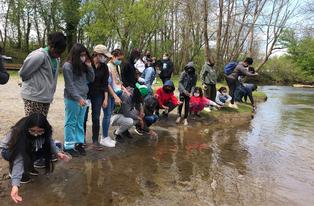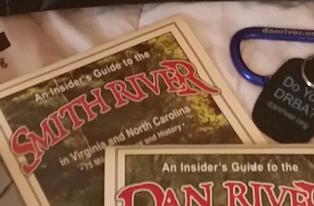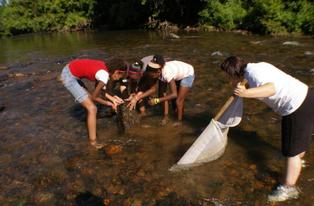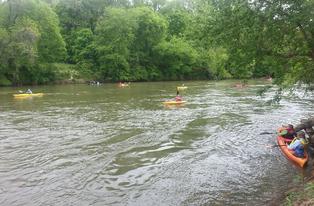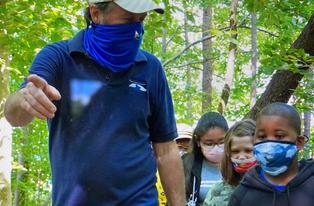Storm Drain Project
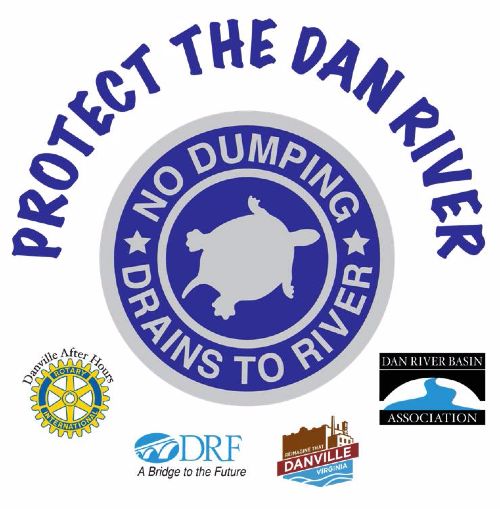 Steps for Completing a Storm Drain Stenciling Project in Your Area
Steps for Completing a Storm Drain Stenciling Project in Your Area
Most towns and cities have developed and maintain an extensive storm drain system. Water traveling through these systems of drains, pipes, culverts, and outlets eventually finds its way untreated to the Dan River and its tributaries, the Smith, Mayo, Bannister, Hyco & Sandy. Storm drain labels remind us to keep storm drains clean in order to protect the rivers and streams we use for recreation and where thousands of residents get their drinking water.
Preparing for your project.
1. First, think about where you would like to do your project and at what scale. Do you want to mark all storm drains in your neighborhood or by your school, or just a few? Also be mindful of what date you choose to stencil drains - in order for the paint to dry properly, it must be 50 degrees Fahrenheit and dry outside.
2. If you think the storm drain you want to mark is on city/public property or in a right of way, DRBA will contact your town or city Public Works department to confirm and request permission to mark the drain. If the storm drain(s) you want to mark are on private property (i.e. a business) you will want to contact the business or landowner for permission.
3. Next, Click here to fill out an application/request. Once you have followed the directions and completed the form, please email it to DRBA. Once your request has been processed we will be in touch to coordinate further details, such as pick up/drop off of stenciling kit(s). Please submit the application 2-4 weeks in advance of the scheduled stenciling date to allow adequate time for staff to review the request.
4. Once you have received the go ahead from DRBA and have picked up your kit(s), you will need to print out/review the following paperwork before the proposed date for your project to ensure you are prepared:
- Waivers of Liability (print enough for all participants; must be returned prior to event)
- Storm Drain Data Sheet & Location Form
- Volunteer Safety Guidelines
- Storm Drain Stenciling Kit Checklist and Step-by-Step Directions
5. If the storm drains you wish to mark are adjacent to private property or business, consider developing a storm drain education/event flyer or writing an article to share with the homes/businesses in your project area. This will help to spread the word to others about the connection between storm drains and our streams/rivers and allow them to feel involved in the project.
6. Make sure you know how many plan to participate and that you have received Waivers of Liability from everyone prior to the start of your project.
The day of your project.
1. The day is here! Either before you head to your site or after you have arrived (carpool if you can!), start with safety first (see Volunteer Safety Guidelines and review with your group).
2. For the actual storm drain marking, please refer to the Storm Drain Stenciling Kit Checklist and Step-by-Step Directions (one should be provided, along with a supply checklist, in the stenciling kit provided). Expect it to take 15-30 minutes per storm drain, including preparation and drying time.
3. Take pictures of you and your group! Make sure to take pictures as you are painting/stenciling as well as after with the finished product. Send pictures to DRBA and share on your group or personal Facebook page to help us promote the program!
4. Be proud of the efforts you and your group have made to keep your community's rivers and streams clean! Once you have returned the stenciling kit, you will receive a certificate of completion and appreciation for you and your group.
After the storm drains have been stenciled.
Please consider continuing your efforts by participating in our Adopt-a-Drain program.
Here's how:
1. Remember the storm drains you and your group stenciled with the message "Dump No Waste, Drains to River"? Adopting those drains is as easy as notifying DRBA that you would like to adopt and visiting the sites every so often and doing a visual assessment.
2. A visual assessment of the storm drain can be done by anyone at anytime, and requires no training. Adopt-a-Storm Drain volunteers are encouraged to visit the adopted storm drain(s) on somewhat regular basis (depending on whether the drain location is near or part of your routine, this could mean daily, weekly or monthly visits). During their visits, volunteers will use their eyes (and maybe even nose!) to identify and then report potential threats such as sightings of animals, spills, dumping, unusual object or litter near or in the storm drain.
3. Any problems or potential threats to your storm drain or local water quality, please contact DRBA in Virginia or North Carolina.
